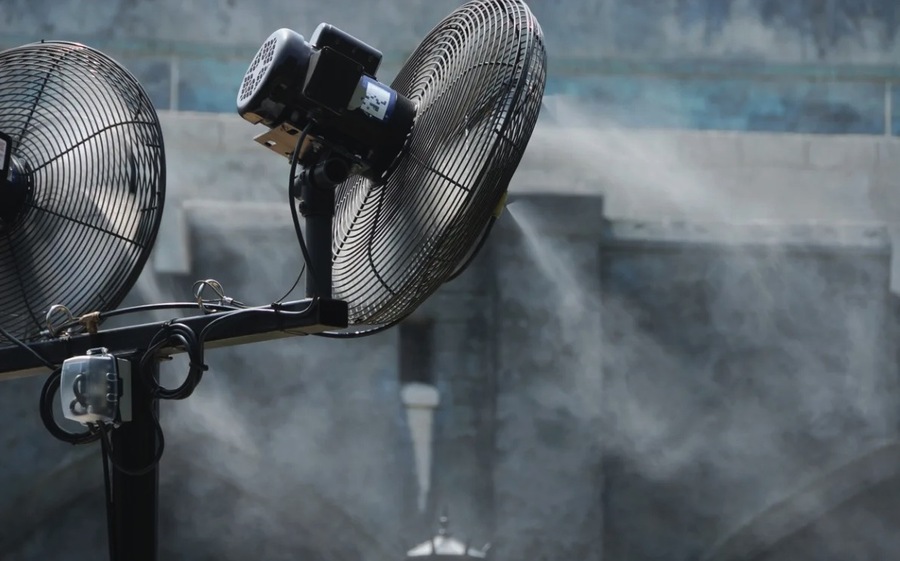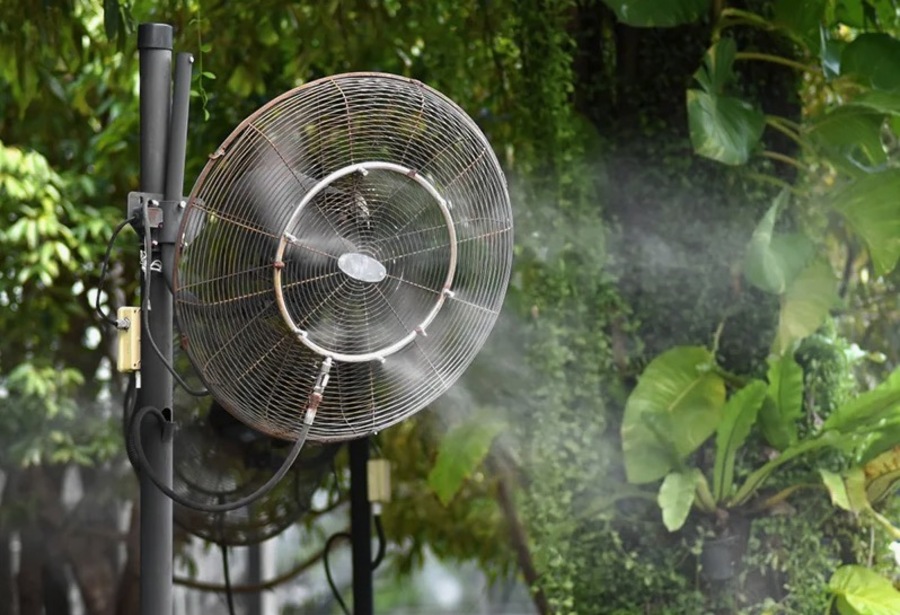What is a Fogging Fan?
A fogging fan is a sophisticated cooling device that combines the functionality of a traditional fan with the cooling effects of misting systems. These fans are designed to release fine mist droplets through high-pressure pumps, which then evaporate and cool the surrounding air. This technology is particularly effective in hot climates, providing relief from heat without soaking the area or individuals with water. The fine mist is light enough to evaporate quickly, making fogging fans an efficient and practical solution for indoor and outdoor cooling. For your next event, consider a mist cooler for rent to keep your guests comfortable and cool.
History of the Creation and Development of Fans
Early Beginnings
The history of fans dates back to ancient civilizations. The first attempts to create effective ventilation systems can be seen in Ancient Egypt, where buildings were designed to facilitate natural air circulation. The earliest prototypes of fans were simple handheld devices made from feathers or leaves attached to long handles. These early fans were used by servants to create a cooling breeze for Egyptian royalty.
Advancements in the Middle East
In the Middle East, rulers used “punkahs,” large wooden frames covered with canvas suspended from ceilings and swung by servants to cool the air. These punkahs represented an early form of mechanical ventilation and were common in rulers’ palaces.
Renaissance Innovations
Leonardo da Vinci is often credited with a significant milestone in fan development. His designs for a helicopter, while not intended for cooling, are considered precursors to modern fan technology due to their ability to generate air flows. Leonardo’s ingenious inventions laid the groundwork for many modern devices, including fans.
The Industrial Revolution and Electric Fans
By the 16th century, mechanical devices for air movement began to emerge. These early fans used a variety of power sources, including water, steam, and, later, kerosene or alcohol engines. The advent of the electric fan revolutionized air cooling. Louis Stein patented the first electric fan in 1854, marking the beginning of modern fan technology.
Under the brand name Union Electro Motors, Scott Sims made significant strides with his patent in 1874. Schuyler Wheeler is also notable, having patented his version of the electric fan in 1886 and founding the Crocker-Wheeler Co. Philip Diehl’sDiehl’s invention of the ceiling fan in 1882, which later incorporated lighting to become known as the “Diehl chandelier,” further advanced fan technology.
Commercial Production
By the end of the 19th century, electric fans were commercially produced. Crocker & Curtis was among the first to mass-produce electric fans. This commercialization made fans more accessible to the general public, transforming them from luxury items to household necessities.

Main Types of Fans
Today, fans come in various types, each designed to meet specific cooling needs:
- Ceiling Fan: Mounted on the ceiling, these fans circulate air evenly across a room, often featuring lighting fixtures. They are ideal for large spaces and help in maintaining consistent airflow.
- Table Fan: Portable and versatile, table fans are ideal for personal use, providing direct airflow where needed. They are commonly used in homes and offices.
- Tower Fan: Tall and slim, tower fans are designed for oscillating air distribution space-efficiently. They are perfect for small to medium-sized rooms.
- Fan on Stand: Adjustable in height, these fans can be directed at various angles, making them suitable for larger areas. They are often used in industrial and commercial settings.
- Exhaust Fan: This type of fan removes stale air, odors, and moisture from spaces like kitchens and bathrooms. It helps maintain air quality by expelling unwanted air.
- Wall Fan: Mounted on walls, these fans save floor space and effectively circulate air in specific areas. They are commonly used in commercial and industrial environments.
- Mist Fan: These fans combine cooling air with misting technology to significantly reduce temperatures. They are especially useful in outdoor settings and can operate with minimal energy compared to traditional air conditioners.
The Unique Advantage of Fogging Fans
Fogging fans stand out because they can cool environments using fine mist, providing a refreshing breeze without wetting the area. These fans require a water supply, which is released as mist through high-pressure pumps. The fog then mixes with the warm air, cooling it down efficiently.
The mist produced is so fine that it does not wet the skin or clothing, making it an ideal solution for maintaining comfort during hot weather. Additionally, fogging fans are significantly more energy-efficient than air conditioners, with a typical energy consumption of around 30 watts compared to the 900 watts used by portable air conditioners.
Practical Applications and Recommendations
Fogging fans are particularly beneficial for outdoor events such as street parties, weddings, and other gatherings in hot climates like Dubai. For anyone planning an event and looking for an effective and economical cooling solution, fogging fans provide an ideal choice. They ensure a comfortable atmosphere without the high energy costs associated with air conditioning.
Here are some specific applications and benefits of fogging fans:
-Outdoor Events: Fogging fans are ideal for cooling large outdoor spaces and can keep guests comfortable at weddings, parties, and corporate events.
-Commercial Use: Restaurants and cafes with outdoor seating areas can use fogging fans to create a pleasant dining experience for customers.
-Industrial Use: Fogging fans can help reduce heat in warehouses and factories, improving working conditions and productivity.
– Residential Use: Homeowners can use fogging fans in patios, gardens, and pool areas to enjoy the outdoors without the discomfort of high temperatures.

Choosing the Right Fogging Fan
When selecting a fogging fan, consider the following factors:
-Area Coverage: Ensure the fan can effectively cover the desired area. Larger fans are suitable for bigger spaces, while smaller fans are ideal for personal use.
– Water Capacity: Check the water tank capacity and the duration of misting. A larger tank means longer cooling periods without refilling.
– Energy Efficiency: Opt for energy-efficient models to save on electricity costs.
– Portability: If you need to move the fan frequently, choose a portable model with wheels for easy transportation.
– Durability: Look for robust construction, especially if the fan will be used outdoors.
Conclusion
Fogging fans represent a perfect blend of efficiency and innovation, offering an eco-friendly and cost-effective cooling solution for various environments. Whether you’re hosting an outdoor event, running a commercial space, or simply looking to stay cool at home, fogging fans provide an effective and energy-efficient alternative to traditional air conditioning.
Their rich history, from ancient Egypt to modern-day innovations, highlights fans’ continuous evolution and importance in our daily lives. Choosing the right type of fan for your needs allows you to enjoy a comfortable, cool environment, no matter the setting.

Hiking addict, vegan, fender owner, Eames fan and brand builder. Working at the nexus of simplicity and intellectual purity to answer design problems with honest solutions. Concept is the foundation of everything else.
